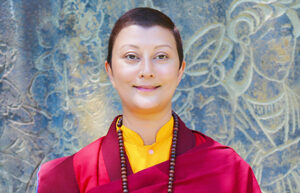


Aria Drolma left her career as a fashion model, embarked on a traditional Buddhist three-year and three-month silent retreat, took the vows of an ordained Buddhist nun, and learned how to live in the present moment.
Lama Aria Drolma: Yes, a big difference. While living in New York City, the value of time is material, and you often hear the phrase “time is money.” Likewise during the three-year retreat, time was very important, but in a different way. We contemplated “Time and Impermanence,” one of the four Buddhist thoughts that turn the mind to dharma. It teaches that everything in this world is impermanent. The next breath may be our last. I began to understand every moment in reference to impermanence.
The first year felt very slow. The second year was a little faster than the first, and the last year zipped by! When I came out of the retreat, I wished that it had lasted one more year.
In the retreat we followed time by the sounds of a gong or a bell. I did not wear a watch and there was one very precise clock. Each month one of us was the timekeeper. We rang a bell for breakfast, lunch, and dinner, while every practice began with a gong. The first meditation began at 4:00 a.m. I had an alarm, but I always woke up a minute or two before it rang. I developed an internal clock that I had lost when I lived in New York City. I think that’s true for many people. We don’t depend on our internal abilities; we tend to look outward instead.
Before the retreat, when I thought of the future, the unknown was quite daunting, and yet at the same time, it was exciting since the canvas was so huge to create whatever I desired. By nature I’m a very positive person. I was confident I could set any goal and achieve it. But there came a time when I felt I was at life’s crossroads—my spiritual seeking was overpowering. Everything that seemed exciting became overwhelmingly meaningless and senseless. My life goals that had at one point been all consuming seemed uninteresting and unimportant. I was seeking answers for my life’s purpose. I was searching for more meaning in life.
The year 2008 was a time of soul searching. I found a Tibetan Buddhist meditation center in New York City, and I was determined to make positive changes in my life. My exciting lifestyle and fashion career were becoming more and more meaningless and senseless. I made a firm New Year’s resolution to start to meditate again and to enrich my life spiritually. Through the practice I began to see how our thoughts create the suffering in our day-to-day lives based on hope and fear—hope for the future and the fear that we may not attain our dreams. During meditation I learned to observe my thoughts and to not follow the past thoughts, since the past is gone, and to not follow the thoughts of the future, since it’s not here yet, but to rest in the present moment.
When I was around eight-years old, my father left the family to become a renunciate, a sadhu. This planted a seed in my mind for my own spiritual awakening. Whenever I saw a holy man wandering the streets, I would look to see if it was my father. As was the custom in India, we always offered food for the holy men, and I would make sure we always had a plate ready in case my father returned home. The pivotal point in my spiritual awakening was when my mother passed away. The pain of losing my mother was intolerable after losing my father as a child. I learned the most meaningful lesson of impermanence: I realized that life is short and nothing lasts forever.
Our day began at 4:00 a.m. and ended at 9:50 p.m. For most of the day we were silent. We were allowed a short period of time after lunch when we could speak. Inside the retreat it was mostly silent, but we could communicate with notes if needed.
There were no newspapers, computers, or internet, and no phones were allowed. We could write two letters each week and receive letters and parcels each Friday. We were allowed to send four letters a month to friends and family, but if we needed we could write more letters. Receiving and writing a letter was a big distraction, so I kept it to the minimum. We were not allowed to step out of the boundaries of the two retreat houses (drupkang), one for men and one for women. We had a small courtyard we could walk around if we had time in the afternoon. If there was a medical emergency, we could of course leave for treatment.
Even when I was modeling and working in advertising, I felt that there was one side of me that was into the glamour world, while the other side was very spiritual. Although I enjoyed the creative side and all the beauty and glamour, I noticed how shallow my former world really is. I began to recognize the illusion of it all. When I was working in advertising, I noticed that our creative team would Photoshop the images of even the most beautiful model who was chosen for a catalogue’s cover. I realized that even she was not perfect and not really who she was portrayed to be. What were we saying to the young people who wanted to be like the model on the cover? What we were portraying was a total illusion.
The reason is explained in Jamgon Kongtrul’s Retreat Manual. Briefly, according to the Buddhist Kalachakra, or Wheel of Time, “The most fundamental relationship with the outside world after birth is through the breath.” The manual tells us that there are 21,600 minutes in one year, which corresponds to the number of breaths we take each day. A small percentage of each breath—1/32—is considered “wisdom energy.” According to Tantric Buddhism, our bodies can last one hundred years. If you do a little math, you’ll see that the wisdom energy accumulated over that time is equivalent to the span of three years, three months, and three days. That becomes the ideal length of time for the retreat and the time required to change karmic energy into wisdom energy.

Lama Aria Drolma is an ordained Buddhist teacher in the Karma Kagyu tradition of Tibetan Buddhism, who has completed over a decade of monastic study and meditation training. She is a graduate of the traditional Tibetan Buddhist retreat program spanning three years and three months, an advanced cloistered meditation training program at Palpung Thubten Choling Monastery, New York.
Lama teaches worldwide, leading retreats, workshops, and corporate meditation programs and is a popular guest speaker at universities and organizations. She emphasizes Vajrayana Buddhism and Buddhist principles, making them relevant in our everyday lives, helping us to cultivate loving kindness and compassion, and bringing about a transformation of contentment and a genuine sense of well-being.

Howard Kaplan is an editor and writer who helped found Spiral magazine in 2017. He currently works at the Smithsonian and divides his time between Washington, DC, and New York City.


Get the latest news and stories from the Rubin, plus occasional information on how to support our work.